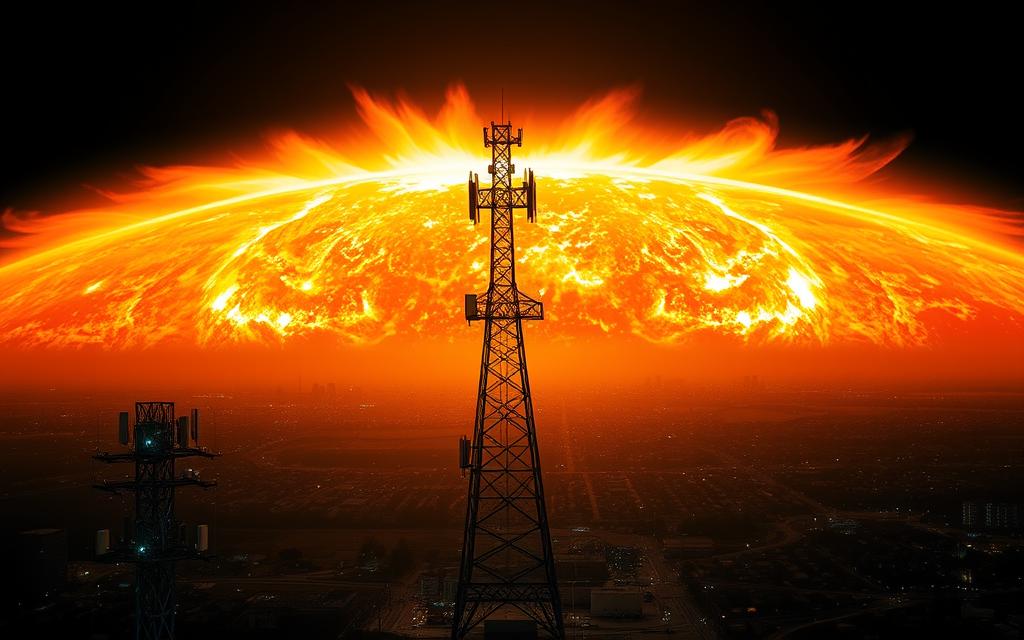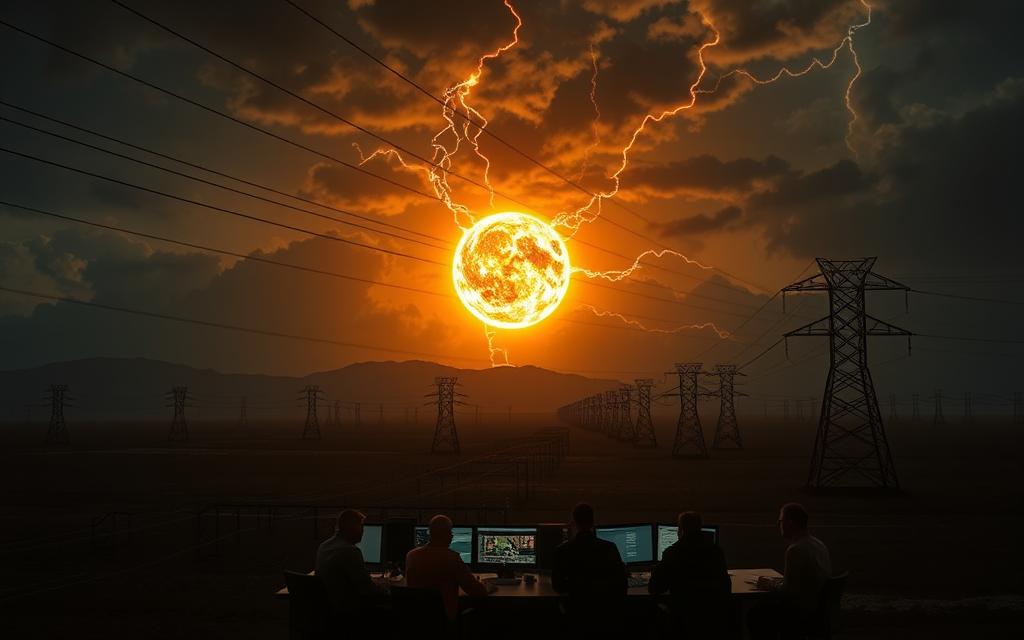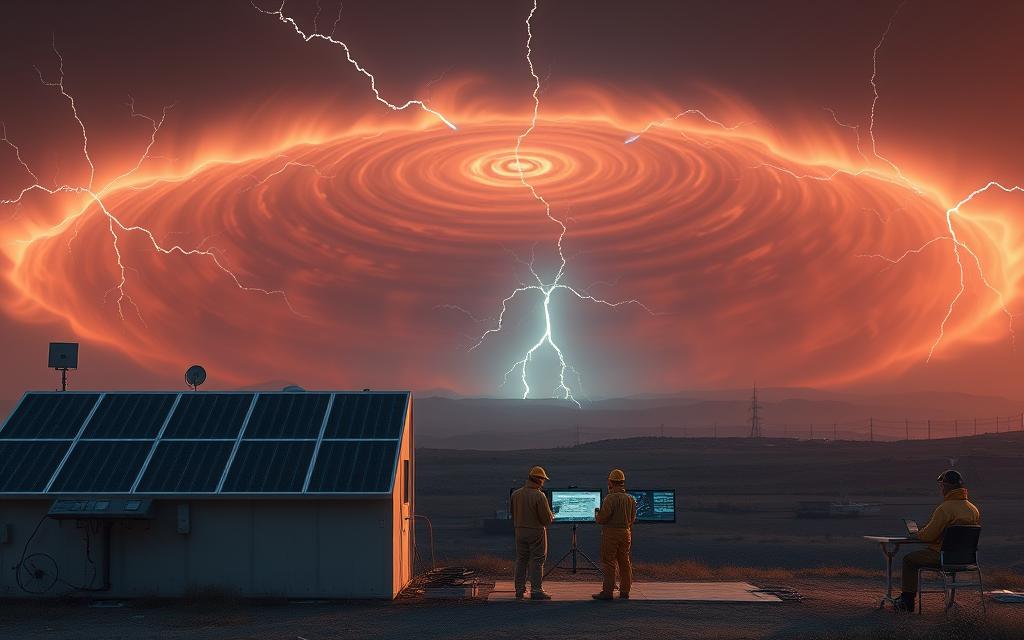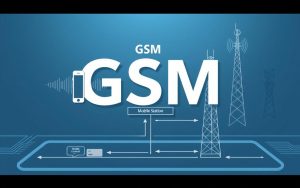In September 1859, sparks flew from telegraph equipment as auroras lit up the sky from Cuba to Hawaii. This was the Carrington Event, the most intense geomagnetic storm in history. It showed how early technology was vulnerable.
Now, 165 years later, space weather risks threaten our advanced technology. Our ancestors couldn’t have imagined these risks.
This May, Ohio farmers faced a problem when tractor GPS systems failed during planting. The issue was linked to increased solar activity. This left tractors stuck in Midwestern fields.
Such problems show how twenty-first-century infrastructure is vulnerable to space weather. Today’s issues include power grid problems and communication blackouts. These are caused by solar eruptions and Earth’s magnetic field.
Unlike old telegraph lines, today’s challenges involve undersea cables, satellites, and smart grids. Yet, we’re not ready for these threats.
Recent events highlight the need for geomagnetic storm preparedness. Governments and industries must act fast. We need to learn from history and current events. The risks are high in our connected world.
Understanding Solar Flares and Space Weather
Our sun’s activity affects Earth’s technology. To understand why, we need to know about solar eruptions and their cycles.
What Are Solar Flares?
Solar flares are huge energy releases in the sun’s atmosphere. They happen when magnetic fields suddenly change, a process called magnetic reconnection.
The Science Behind Coronal Mass Ejections
Coronal mass ejections (CMEs) often follow big flares. They send huge plasma clouds into space at 3 million mph. NASA’s Solar Dynamics Observatory caught this in May 2024’s X-class flare, showing:
- Magnetic loop structures spanning 10 Earth diameters
- Plasma temperatures exceeding 10 million °C
- Accelerated particles creating secondary radiation bursts
Classification Systems (X-Class Flares)
Scientists use a logarithmic scale to classify flares by X-ray wavelengths:
| Class | Peak Flux (Watts/m²) | Typical Effects |
|---|---|---|
| X | 10⁻⁴ | Global radio blackouts, radiation storms |
| M | 10⁻⁵ | Regional communications disruptions |
| C | 10⁻⁶ | Minor satellite interference |
The 2003 X28 flare was 45 times stronger than usual X1 events. It’s the record for extreme space weather.
The Solar Cycle Connection
Solar activity goes through an 11-year cycle. The solar maximum 2024 is part of Cycle 25. This peak time means more flares because of:
11-Year Activity Patterns
NOAA’s Geostationary Operational Environmental Satellites (GOES) track these cycles. They watch:
- Sunspot group formations
- Magnetic field complexity
- Coronal hole development
Predicting Geomagnetic Storms
Michigan State University’s models use solar images and history to predict CME impacts. Dr. Elena Petrova says:
“Modern algorithms give us 12-48 hours’ warning for major geomagnetic storms. This is vital time for grid operators to protect their systems.”
These systems were key in 2022’s near-miss X15 flare. They helped satellite operators protect their electronics.
Mechanisms: How Solar Flares Disrupt Modern Technology
Space weather affects our modern world in many ways. Solar particles interact with Earth’s magnetic field, causing problems. This affects systems we all use every day.
Power Grid Vulnerabilities
Geomagnetically induced currents (GICs) turn power networks into antennas during solar storms. These currents target transformers, which cost £2 million each. They control voltage across continents.
Transformer saturation risks
GICs over 75-100 amps can harm transformers. This leads to:
- Harmonic distortions reducing efficiency by 15-20%
- Overheating risks shortening equipment lifespan
- System-wide voltage collapses within 30 seconds
1989 Quebec blackout case study
The 9-hour outage in 1989 cost Hydro-Québec £6.5 million. The storm caused 120A GICs, tripling normal levels. This collapsed 7 major transformers at once. “We became a textbook example overnight,” says Jean Dupont, the former grid operator.

Communications System Impacts
Solar events cause problems for communications. GPS accuracy drops from 5 metres to 50 metres during storms, reports the 2023 FAA.
GPS signal degradation
Military and aviation systems are hit hard:
- Precision landing systems become unreliable
- Satellite timing errors disrupt financial transactions
- Emergency location beacons lose 80% effectiveness
Satellite operation challenges
SpaceX lost 38 Starlink satellites in 2022 due to storm-induced drag. New standards require:
- Triple-layer radiation barriers
- Automated orbit adjustment protocols
- Redundant communication arrays
Aviation and Transportation Risks
Radiation at 12km altitudes is as strong as chest X-rays. NASA’s AIRS project found pilots get 300% more particles on polar routes.
High-altitude radiation exposure
Aviation rules now include:
- Altitude restrictions below 7,500m during alerts
- Pregnancy bans on transpolar flights
- Real-time crew dosage monitoring
Flight rerouting costs
Storm diversions in 2021 cost US carriers £18 million. The FAA’s new rules require:
- 4-hour advance weather briefings
- Alternative airport reservations
- Double crew staffing on polar routes
Historical Precedents and Modern Consequences
Solar storms have had a big impact on human technology for centuries. They show us patterns that we need to pay attention to today. In the 8th century, the Miyake Event radiation spikes in tree rings warned us of cosmic dangers. Now, we face risks to our power grids, satellites, and GPS systems.
The Carrington Event (1859)
In 1859, a solar storm caused telegraph offices to spark without battery power. This event is seen as the worst-case scenario.
Telegraph system failures
Geomagnetically induced currents (GICs) caused fires and electrocution risks in copper lines. Today, systems like SCADA face similar threats from solar events.
“A repeat Carrington Event could disable 300+ EHV transformers in the US grid simultaneously.”
Near-Miss Events in the Space Age
NASA said a 2012 coronal mass ejection (CME) missed Earth by nine days. A direct hit could have caused 18-month blackouts worldwide. More recently:
2012 solar superstorm
This plasma cloud had 1022 joules of energy, like 1 billion atomic bombs. It caused temporary malfunctions in GPS networks, showing risks to aviation.
2022 Starlink satellite loss
SpaceX lost 40 Starlink units in a moderate geomagnetic storm. The charged particles heated the atmosphere, causing drag. This affects over 5,000 low-Earth orbit satellites today.
| Event | Year | Impact Scale | Modern Equivalent Risk |
|---|---|---|---|
| Carrington Event | 1859 | Regional grid collapse | National blackouts (12-24 months) |
| 2012 CME Near-Miss | 2012 | Global GPS disruption | $2.4 trillion economic loss |
| Starlink Incident | 2022 | $100m satellite loss | LEO communication gaps |
Tree ring data from 774AD shows a carbon-14 spike 20 times stronger than Carrington’s effects. This tells us we need to consider long timescales when calculating Carrington-class storm probability. With 95% of undersea internet cables at risk, we must learn from history to find modern solutions.
Mitigation Strategies for Critical Infrastructure
As solar activity grows, protecting power grids and satellites is essential. New engineering and predictive systems help reduce risks. They ensure our systems keep working even in extreme weather.

Grid Hardening Techniques
Electricity networks are using neutral grounding resistors to fight geomagnetically induced currents (GICs). Michigan State University found these devices stop transformer failures during solar storms. Siemens’ SATIR systems also help by spotting grid issues quickly.
Faraday cages for substations
High-risk places are now using electromagnetic shielding. Faraday cages stop currents and let for maintenance. Recent studies show a 92% drop in surge outages.
Satellite Protection Measures
Operators are focusing on radiation-hardened electronics for key systems. Intelsat’s 2023 plans show a 40% cost cut by combining hardening with:
- Automated safe-mode activation
- Altitudinal orbit adjustments
- Redundant communication pathways
Orbital position adjustments
Satellites in geostationary orbit can move during solar events. This cuts radiation by 65%, ESA’s 2024 report says.
Early Warning Systems
NASA’s Solar Dynamics Observatory uses SDO helioseismology to forecast flares 48 hours ahead. An engineer says:
“Our magnetogram updates every 10 seconds – it’s like having a live weather map for the Sun.”
NOAA Space Weather Prediction Center
The SWPC’s 30-minute alert system starts automatic protections in US infrastructure. Their work with the ESCAPADE Mars mission improves forecasts with deep-space data.
Building Resilience Against Solar Storm Threats
Modern infrastructure is facing big risks from extreme space weather. New NERC grid standards require quick action to protect against solar flares. This means operators must act fast, within 72 hours, to prepare for sudden threats.
International teamwork is key to getting ready for space weather. Projects like CERN’s radiation monitoring show how sharing data helps predict storms better. Satellites and planes use these efforts to stay safe in the skies.
Researchers at Mississippi State University say we’re not ready for big solar storms. They say we need to work faster to protect our power systems. Installing Faraday cages and sensors is essential to keep our power on.
Investing in early warning systems and backup networks is our best defence. Working together, we can make our systems strong against future storms. This way, we can face what history tells us is coming.







